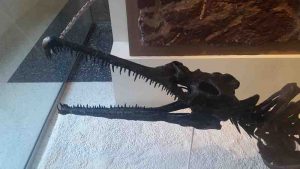
The Triassic Period was a time of fantastic reptilian experimentation. Among archosaurs, there were the armored aetosaurs, the predatory rauisuchians, an abundance of early dinosaurs and near-dinosaurs, the ancestors of crocodilians, and more. Amidst all of this diversity, one of the most famous and widespread groups were the phytosaurs.
Phytosaurs are deceptively crocodile-like, with large bodies up to 6 meters or more, long toothy snouts, and sprawling limbs. But a closer examination reveals that they aren’t crocodilian at all – their nostrils are near their eyes instead of at the tip of their snouts, for example – but exactly where they fit on the archosaur family tree is uncertain. And exactly how they came to be so croc-like is mysterious as well. Like many Triassic reptile groups, phytosaurs are preserved almost exclusively in Late Triassic rocks, and by that time they had already evolved their iconic features and become widespread across the Pangaean supercontinent. Their earlier years are unknown.
But the fog hanging over the early evolution of phytosaurs has lifted slightly with the discovery of a new species: Diandongosuchus fuyuanensis, the first known Middle Triassic phytosaur.
As its name suggests, Diandongosuchus was discovered in Fuyuan County in the Yunnan Province of China. It’s an unusual animal, and was originally described in a 2012 paper as a member of another group of reptiles, the poposaurs. But Dr. Michelle Stocker of Virginia Tech wanted a closer look. “I had seen it in print first,” she told me, “and realized from all of the figures that were in the paper that this looks really similar to phytosaurs.”
Stocker spoke with me after presenting her research at the Triassic-Jurassic Research Symposium at the Bruce Museum last month.
Sure enough, detailed inspection of the new fossil, published earlier this year, reveals that the limbs, shoulders, skull, and teeth all exhibit classic phytosaur features. But Diandongosuchus has a weird face. For one thing, its snout is noticeably shorter than those of Late Triassic phytosaurs. For another, its nostrils are not positioned up by the eyes as in its later cousins, but they also aren’t out at the tip of the snout as in other archosaurs (and presumably the phytosaurs’ earliest ancestors). Instead, they’re located in between, partway along the snout.
With its unusual combination of traits, Diandongosuchus represents the first known transitional phytosaur.
Dating to the Ladinian stage of the Middle Triassic, it lived about 10 million years earlier than the next-oldest phytosaurs. Its post-cranium (everything behind the skull) and the back of its skull were already very much like what we see in Late Triassic phytosaurs, indicating that those features evolved early. But the familiar features of long snouts and larger body size seem to have been later innovations.
Stocker suspects this pattern of change reflects a change in phytosaurs’ lifestyle. “In both crocodilians and phytosaurs there seems to be a trend of going from small-ish species that maybe aren’t the top of the food chain to being very large semi-aquatic predators.”
Notably, another feature that Diandongosuchus lacks is the zig-zag connection between upper jaw bones (the maxillary and premaxillary) that provides extra strength to the jaw, something seen only in later phytosaurs and crocodilians.
“We suspect that phytosaurs occupied near-shore marine environments,” Stocker explained. “kind of like a Nile crocodile or saltwater crocodile does today.” Diandongosuchus was discovered in the marine sediments of the Falang Formation – it even had the remains of fish in its stomach! – which suggests that these aquatic habits arose early in the phytosaur lineage. Following coastlines or even open water may have allowed them to reach the far corners of Pangea, from North America to China, early on in their history.
I should mention that there was another fossil, a partial skull from Germany named Mesorhinosuchus, which was at one time thought to be an Early Triassic phytosaur. However, the age of the specimen has been debated, and the fossil itself was unfortunately destroyed during World War II. For now, Diandongosuchus is the only window we have into early phytosaur history.
No doubt further early phytosaurs await discovery. Stocker and colleagues have been searching for many years in Early and Middle Triassic terrestrial sediments in the southwestern United States and Tanzania – indeed, I spoke to her just two days before she headed back out to the field – and are now thinking about adding more oceanic sites to the list.
“Expanding our search to other Early-Middle Triassic marine deposits might be a good idea to look for more of those early members of the group,” she said.
Reference:
- Chun Li et al. A new archosaur (Diapsida, Archosauriformes) from the marine Triassic of China, Journal of Vertebrate Paleontology (2012). DOI: 10.1080/02724634.2012.694383
- Michelle R. Stocker et al. A Short-Snouted, Middle Triassic Phytosaur and its Implications for the Morphological Evolution and Biogeography of Phytosauria, Scientific Reports (2017). DOI: 10.1038/srep46028
Note: The above post is reprinted from materials provided by Public Library of Science. This story is republished courtesy of PLOS Blogs










